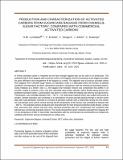| dc.contributor.author | HM Lumadede⃰⃰⃰⃰, P Kuloba, F Kengara, J Aluha, C Kowenje | |
| dc.date.accessioned | 2022-01-22T09:55:00Z | |
| dc.date.available | 2022-01-22T09:55:00Z | |
| dc.date.issued | 2020 | |
| dc.identifier.uri | https://repository.maseno.ac.ke/handle/123456789/4515 | |
| dc.description | URL:https://www.kesebae.or.ke/journal/static/pdf/volume6/1.2020/jeae-volume6-no1.2020-3.pdf | en_US |
| dc.description.abstract | In Kenya activated carbon is imported yet we have enough bagasse that can be used in its production. The
activated carbon from bagasse adds economic value to the bagasse and the processing excess bagasse provides
for good utilization and management of the bagasse as a waste. The objective was to produce activated carbon
from bagasse from Chemelil sugar factory on laboratory scale in a fabricated retort and furnace at selected
conditions of temperature and time, characterize and give a comparison with the commercial activated carbons.
Using molasses as a binder, ratio 1:1, the bagasse and molasses mixture was compressed into pellets in an
extruder, heated to produce a char, and then activated using carbon dioxide, before finally being ground into
powdered activated carbon. Carbonization was done in a retort, while the heating was done by two gas burners.
Temperature, was controlled between 300 – 700 o
C. The carbonized material (char) was cooled and ground to
powder. Sample activation was conducted in an atmosphere of carbon dioxide passing through a chrome-nickel
pipe with a gas distributor mounted in a furnace of porcelain cylinder with a metal sheet having one end closed.
Air and nitrogen were used to control burning and the temperature of the furnace was controlled to between 300
– 600 o
C. The activated carbons produced were characterized for their physical properties (bulk density, surface
area, and micro pore volume and pore size), chemical properties (ash, pH, conductivity) and compared with
selected two commercial activated carbons. The results showed that carbon materials activated from bagasse for
5 h at a temperature of 600 o
C had similar characteristics w | en_US |
| dc.publisher | Journal of Engineering in Agriculture and the Environment | en_US |
| dc.subject | Sugarcane Bagasse, Activated Carbon, BET surface area, Adsorption | en_US |
| dc.title | Production and characterization of activated carbons from sugarcane bagasse from Chemelil sugar factory, compared with commercial activated carbons | en_US |
| dc.type | Article | en_US |

